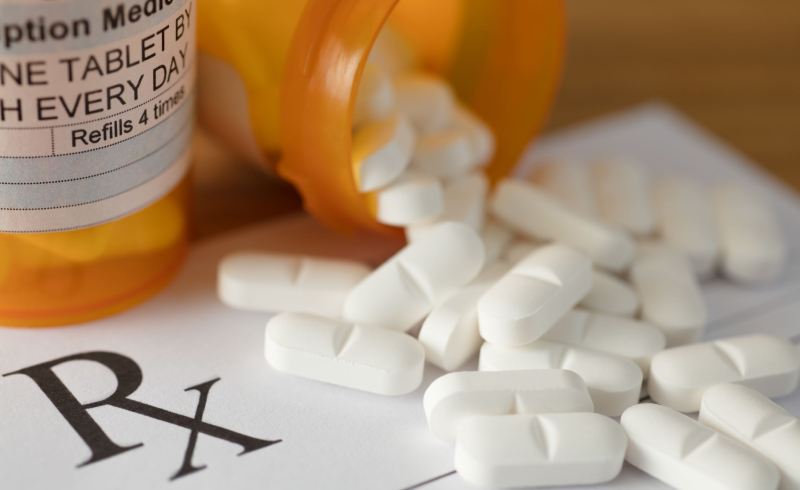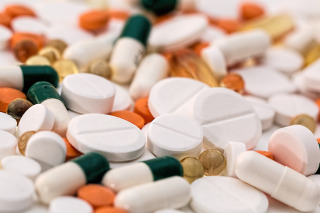
Think about the following questions.
1. Do you know anyone who has ever been addicted to drugs?
2. Why do you suppose some people like to use drugs even when they know that drugs are bad for their health?
3. Which should the government focus more on, punishing drug users or treating them?
VOCABULARY PREVIEW
Match each New Academic Word List(NAWL) word with the correct definition.
- chronic
- classification _____
- derivative _____
- fever _____
- dependence _____
- synthetic _____
- a. man-made; not natural
- b. continuing or being repeated again and again for a long time
- c. a high body temperature associated with illness
- d. the arrangement of individual items into categories
- e. a substance that comes from another substance
- f. the state of being addicted to something
MORPHINE

Morphine is a very potent1 member of the opioid family of drugs used in the field of medicine to relieve pain. Opioids are natural products of poppy seeds, and synthetic versions can be manufactured. They work on the area of the brain that perceives pain, reducing the sensation. Because morphine is such a strong drug, it is meant to be used only by people in severe pain. This is because the side effects are significant, and the risk of addiction is high. Morphine can be taken as needed for certain types of acute (severe) pain, such as that caused by a bad injury. It can also be administered continuously for relief of chronic pain, such as that experienced by cancer patients.
Friedrich Wilhelm Adam Sertürner was a German pharmacist who first produced morphine in 1805. Sertürner isolated morphine from opium, which is the dried latex sap present in poppy flower seed pods. It was the first isolated active ingredient of a plant. He called it "morphium" after Morpheus, the Greek god of dreams. Although it is not a hallucinogen2, as the name might imply, it is more than just a pain reliever. Morphine also produces a euphoric mental state and relieves anxiety. This euphoric feeling made it a popular recreational3 drug. Historically, morphine was available over the counter. But widespread abuse led to its classification as a controlled (legally regulated) substance. Heroin is a more potent and faster-acting derivative of morphine, and it soon took over on the street as the opioid of choice. But even today, when heroin addicts have trouble finding their drug, they often use morphine as a substitute. Interestingly, morphine was used early on to treat opium addiction, and even alcoholism, until doctors realized that it was more addictive than both of those drugs.
Because it is so addictive, doctors must exercise caution when prescribing morphine. When it is used to alleviate4 pain in people who are dying, addiction is not a concern, and the drug can help make the patient more comfortable during his or her final days. However, when it is used as an analgesic (pain reliever) in patients who are in severe pain but not dying, precautions should be taken. Dosages5 should be closely monitored, along with the appearance of withdrawal symptoms. Withdrawal is an indicator of addiction. It manifests6 as physical signs of the body's need for the drug. In the case of morphine, these include nausea, diarrhea, fever and chills, watery eyes, a runny nose, headaches, body aches, and irritability. Tolerance is the other main sign of addiction. Tolerance refers to a patient needing larger amounts of a drug to achieve the same effects.
Not only is morphine physically addictive, but it is also psychologically addictive. A morphine addict, having gotten through eight to twelve days of withdrawal without resorting to7 morphine use, no longer has any physical dependence. The body becomes accustomed to not having the drug and resumes normal functioning. The cravings8, however, will persist because the person has become psychologically dependent on the drug. The result is often severe depression and anxiety. Many people have difficulty sleeping and even develop amnesia9. Self-esteem is diminished as the person copes with living life without the help of morphine.
Not surprisingly, relapse10 is very common among morphine addicts, especially when the factors in their lives that led them to drug abuse are not changed. A study of morphine addiction in rats illustrated this point. It showed that if the rat's environment was made richer and more interesting after the removal of morphine doses, it coped better with psychological withdrawal.
Morphine is a highly effective drug that can be used to alleviate pain, but it should be used under the close supervision of a doctor. The risk of addiction is high, and withdrawal is a painful process-the psychological element of which can last a lifetime.
New Academic Word List
- potent 1 : adj. very strong
- hallucinogen 2 : n. a substance that causes the user to see or hear things that are not there
- recreational 3 : adj. used or done for enjoyment
- alleviate 4 : v. to make less painful, difficult, or severe; to relieve
- dosage 5 : n. the amount of a drug that should be taken at one time
- manifest6 : v. to show clearly
- resort to 7 : v. to do or use because no other choices are possible
- craving 8 : n. a strong desire for something
- amnesia 9 : n. memory loss
- relapse 10 : n. a return to previous bad behavior
READING COMPREHENSION
A ‣ Mark each statement as true (T) or false (F) according to the reading.
- Natural opioids are manufactured from part of the poppy plant.
- True
- False
- Morphine was named after the pharmacist who first made it.
- True
- False
- At one time, doctors gave morphine to drug and alcohol addicts.
- True
- False
- Doctors must be careful in prescribing morphine to dying patients.
- True
- False
- Patients are no longer addicted once they build up tolerance.
- True
- False
B ‣ Choose the best answer according to the reading.
- What is the main purpose of the reading?
- a. To argue for the legalization of opioids
- b. To describe the uses and dangers of morphine
- c. To compare different drugs used for pain relief
- d. To explain how morphine is manufactured
- Which of the following is true of heroin?
- a. It is less potent than morphine.
- b. It is a hallucinogen.
- c. It is derived from morphine.
- d. It was named after a god.
- We can guess from paragraph 2 that _____.
- a. heroin was invented before morphine
- b. morphine is less expensive than heroin
- c. heroin is easier for addicts to find than morphine
- d. heroin is also classified as a controlled substance
- What causes morphine cravings after withdrawal?
- a. Physical addiction
- b. Psychological dependence
- c. Depression and anxiety
- d. Insomnia and amnesia
C ‣ The following terms are explained in the reading. Write definitions for them.
- opioids:
_____ - analgesic:
_____ - controlled substance:
_____
SUMMARY
Fill in the blanks with the phrases in the box.
- highly addictive
- blocking sensation
- active ingredient
- German pharmacist
- increased tolerance
- pain reliever
|
Definition
|
|
History
|
|
Risks
|
VOCABULARY PRACTICE
Fill in the blanks with the words in the box. Change the form if necessary.
- chronic
- classification
- dependence
- derivative
- fever
- synthetic
- "High-functioning" alcoholics have developed a(n) _____ on alcohol that does not seem to affect their professional or social lives.
- I've been in bed all week with a(n) _____ and body aches.
- Some people insist on eating only "all-natural" foods because they believe anything _____ must be bad for you.
- Natural gas has many useful _____ , including plastic and paint.
- Taxonomy is the formal name of the field of biological _____ of species.
- Since his teen years, he's been a(n) _____ offender, in and out of jail.
SUPPLEMENTAL READING
Should Drugs Be Legal?

At age eighteen, Americans can legally purchase cigarettes, which contain the drug nicotine. At twenty-one, they can buy and drink beverages with alcohol, another type of drug. Yet, the vast majority of US states still outlaw the recreational use of marijuana. And at no age are people legally allowed to buy and consume other "harder" kinds of drugs such as cocaine or heroin. Many people think this policy is hypocritical. They wonder why the government should have the power to allow some drugs and ban others.
One typical response is that drugs like marijuana and cocaine are unhealthy. But cigarettes and alcohol represent much more serious public-health issues. Smoking, for instance, is the leading cause of preventable deaths in the US, killing more than 480,000 people each year, according to the Centers for Disease Control and Prevention (CDC). The CDC estimates that drinking alcohol leads directly to about 29,000 annual deaths and indirectly to thousands of others. Studies show that when used in moderation, marijuana is considerably less harmful than both cigarettes and alcohol. Of course, some people say that this merely makes such drugs the lesser of two evils. Instead of legalizing new drugs, they argue, the government should make all drugs illegal.
Proponents of legalization counter this by pointing to the rise in violent crime that occurred during the 1920s and 1930s when alcohol was banned in the US. They also assert that legalizing drugs can actually improve the economy. In 2014, Colorado became the first state to fully legalize marijuana and has served as a model in this regard. Since legalization, marijuana sales have generated over $1.6 billion in tax revenue for the state.
Fill in the blanks with information from the reading.
- Two legal drugs for adults in the US are _____ and _____.
- Smoking is the number-one _____ in the US.
- Colorado decided to _____ in 2014.

Leave a comment
Load more